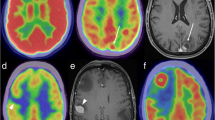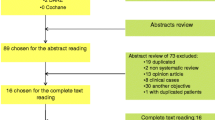Abstract
Purpose
Limited information is available on the use of positron emission tomography (PET) in paediatric oncology. The aim of this study was to review the impact of PET on the management of paediatric patients scanned over a 10-year period.
Methods
One hundred and sixty-five consecutive oncology patients aged 11 months to 17 years were included. Two hundred and thirty-seven scans were performed. Diagnoses included lymphoma (60 patients), central nervous system (CNS) tumour (59), sarcoma (19), plexiform neurofibroma with suspected malignant change (13) and other tumours (14). A questionnaire was sent to the referring clinician to determine whether the PET scan had altered management and whether overall the PET scan was thought to be helpful.
Results
One hundred and eighty-nine (80%) questionnaires for 126 patients were returned (63 relating to lymphoma, 62 to CNS tumours, 30 to sarcoma, 16 to plexiform neurofibroma and 18 to other tumours). PET changed disease management in 46 (24%) cases and was helpful in 141 (75%) cases. PET findings were verified by histology, clinical follow-up or other investigations in 141 cases (75%). The returned questionnaires indicated that PET had led to a management change in 20 (32%) lymphoma cases, nine (15%) CNS tumours, four (13%) sarcomas, nine (56%) plexiform neurofibromas and four (22%) cases of other tumours. PET was thought to be helpful in 47 (75%) lymphoma cases, 48 (77%) CNS tumours, 24 (80%) sarcomas, 11 (69%) neurofibromas and 11 (61%) cases of other tumours. PET findings were verified in 44 (70%) lymphoma cases, 53 (85%) CNS tumours, 21 (70%) sarcomas, 12 (75%) neurofibromas and 11 (61%) other tumour cases.
Conclusion
PET imaging of children with cancer is accurate and practical. PET alters management and is deemed helpful (with or without management change) in a significant number of patients, and the results are comparable with the figures published for the adult oncology population.




Similar content being viewed by others
References
Gambhir SS, Czernin J, Schwimmer J, Silverman DHS, Coleman E, Phelps ME. A tabulated summary of the FDG PET literature. J Nucl Med 2001;42:1S–93S.
Czernin J. Clinical applications of FDG-PET in oncology. Acta Med Austriaca 2002;29:162–70.
Franzius C, Schober O. Assessment of therapy response by FDG PET in pediatric patients. Q J Nucl Med 2003;47:41–5.
Shulkin BL. PET applications in pediatrics. Q J Nucl Med 1997;41:281–91.
Plowman PN, Saunders CAB, Maisey M. On the usefulness of brain PET scanning to the paediatric neuro-oncologist. Br J Neurosurg 1997;11:525–32.
Bruggers CS, Friedman HS, Fuller GN, et al. Comparison of serial PET and MRI scans in a pediatric patient with a brainstem glioma. Med Pediatr Oncol 1993;21:301–6.
Hoffman JM, Hanson MW, Friedman HS, et al. FDG-PET in paediatric posterior fossa brain tumours. J Comput Assist Tomogr 1992;16:62–8.
O’Tuama LA, Phillips PC, Strauss LC, et al. Two-phase [11C]l-methionine PET in childhood brain tumours. Pediatr Neurol 1990;6:163–70.
Ferner RE, Lucas JD, O’Doherty MJ, et al. Evaluation of 18fluorodeoxyglucose positron emission tomography (18FDG PET) in the detection of malignant peripheral nerve sheath tumours arising from within plexiform neurofibromas in neurofibromatosis 1. J Neurol Neurosurg Psychiatry 2000;68:353–7.
Lucas JD, O’Doherty MJ, Wong JCH, et al. Evaluation of fluorodeoxyglucose positron emission tomography in the management of soft-tissue sarcomas. J Bone Joint Surg (Br) 1998;80:441–7.
Wilmshurst JM, Barrington SF, Pritchard D, et al. Positron emission tomography in imaging spinal cord tumours. J Child Neurol 2000;15:465–72.
Meta J, Seltzer M, Schiepers C, et al. Impact of 18F-FDG PET on managing patients with colorectal cancer: the referring physician’s perspective. J Nucl Med 2001;42:586–90.
Gopalan D, Griffiths D, Townsend C, et al. Fluorodeoxyglucose positron emission tomography in clinical oncology: the referrer’s perspective. Nucl Med Commun 2002;23:1041–6.
Cook GJ, Maisey MN, Fogelman I. Normal variants, artefacts, and interpretive pitfalls in PET imaging with 18-fluoro-deoxyglucose and carbon-11 methionine. Eur J Nucl Med 1999;26:1363–78.
Hany TF, Gharehpapagh E, Kamel EM, Buck A, Himms-Hagen J, von Schulthess GK. Brown adipose tissue: a factor to consider in symmetrical tracer uptake in the neck and upper chest region. Eur J Nucl Med Mol Imaging 2002;29:1393–8.
Barrington SF, Maisey MN. Skeletal muscle uptake of fluorine-18-FDG: effect of oral diazepam. J Nucl Med 1996;37:1127–9.
Brink I, Reinhardt MJ, Hoegerle S, Altehoefer C, Moser E, Nitzsche EU. Increased metabolic activity in the thymus gland studied with 18F-FDG PET: age dependency and frequency after chemotherapy. J Nucl Med 2001;42:591–5.
Boivin JF, Hutchinson GB, Zauber AG, et al. Incidence of second cancers in patients treated for Hodgkin’s disease. J Natl Cancer Inst 1995;87:732–4.
Valagussa P, Santoro A, Bonadonna G. Thyroid, pulmonary and cardiac sequelae after treatment for Hodgkin’s disease. Ann Oncol 1992;3:111–5.
Schiepers C, Filmont J-E, Czernin J. PET for staging of Hodgkin’s disease and non-Hodgkin’s lymphoma. Eur J Nucl Med 2003;30(Suppl 1):S82–8.
Reske SN. PET and restaging of malignant lymphoma including residual masses and relapse. Eur J Nucl Med Mol Imaging 2003;30(Suppl 1):S89–96.
Spaepen K, Stroobants S, Verhoef G, et al. Positron emission tomography with [18F]FDG for therapy response monitoring in lymphoma patients. Eur J Nucl Med Mol Imaging 2003;30(Suppl 1):S97–105.
Montravers F, McNamara D, Landman-Parker J, et al. [18F]FDG in childhood lymphoma: clinical utility and impact on management. Eur J Nucl Med Mol Imaging 2002;29:1155–65.
Chao ST, Suh JH, Raja S, Lee SY, Barnett G. The sensitivity and specificity of FDG PET in distinguishing recurrent brain tumor from radionecrosis in patients treated with stereotactic radiosurgery. Int J Cancer 2001;96:191–7.
Crim JR, Seeger LL, Yao L, Chandnani V, Eckardt JJ. Diagnosis of soft-tissue masses with MR imaging: can benign masses be differentiated from malignant ones? Radiology 1992;185:581–6.
Hain SF, O’Doherty MJ, Bingham J, Chinyama C, Smith MA. Can FDG PET be used to successfully direct preoperative biopsy of soft tissue tumours? Nucl Med Commun 2003;24:1139–43.
Pirotte B, Goldman S, Salzberg S, et al. Combined positron emission tomography and magnetic resonance imaging for the planning of stereotactic brain biopsies in children: experience in 9 cases. Pediatr Neurosurg 2003;38:146–55.
Utriainen M, Metsahonkala L, Salmi TT, et al. Metabolic characterisation of childhood brain tumours. Comparison of 18F-fluorodeoxyglucose and 11C-methionine positron emission tomography. Cancer 2002;95:1376–86.
Holthoff VA, Herholz K, Berthold F, et al. In vivo metabolism of childhood posterior fossa tumours and primitive neuroectodermal tumours before and after treatment. Cancer 1993;72:1394–403.
Franzius C, Sciuk J, Brinkschmidt C, Jurgens H, Schrober O. Evaluation of chemotherapy response in primary bone tumours with F-18 FDG positron emission tomography compared with histologically assessed tumour necrosis. Clin Nucl Med 2000;25:874–81.
Franzius C, Daldrup-Link HE, Sciuk J, et al. FDG-PET for detection of pulmonary metastases from malignant primary bone tumors: comparison with spiral CT. Ann Oncol 2001;12:479–86.
Ducatman BS, Scheithauer BW, Piepgras DG, Reiman HM, Ilstrup DM. Malignant peripheral nerve sheath tumours, a clinicopathologic study of 120 cases. Cancer 1986;57:2006–21.
Borgwardt L, Larsen HJ, Pedersen K, Hojgaard L. Practical use and implementation of PET in children in a hospital PET centre. Eur J Nucl Med Mol Imaging 2003;30:1389–97.
Stabin MG, Gelfand MJ. Dosimetry of pediatric nuclear medicine procedures. Q J Nucl Med 1998;42:93–112.
Acknowledgements
The authors would like to thank all the staff at the Clinical PET Centre and recognise their skills in dealing with children. Special thanks are due to over 60 referring consultants who took time from their busy practices to fill out and return the questionnaires.
Author information
Authors and Affiliations
Corresponding author
Rights and permissions
About this article
Cite this article
Wegner, E.A., Barrington, S.F., Kingston, J.E. et al. The impact of PET scanning on management of paediatric oncology patients. Eur J Nucl Med Mol Imaging 32, 23–30 (2005). https://doi.org/10.1007/s00259-004-1645-3
Received:
Accepted:
Published:
Issue Date:
DOI: https://doi.org/10.1007/s00259-004-1645-3




